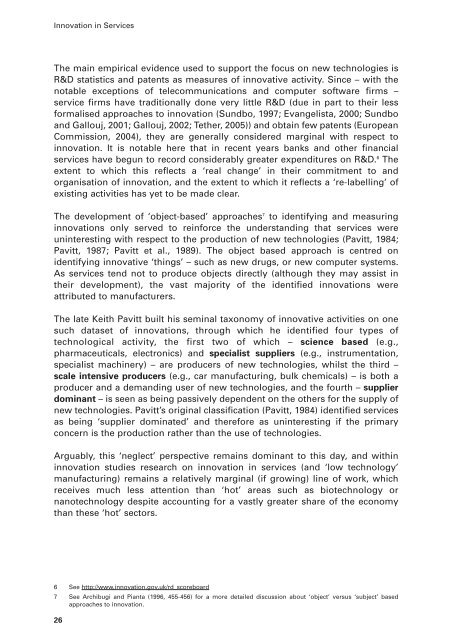Innovation in Services - Department for Business, Innovation and Skills
Innovation in Services - Department for Business, Innovation and Skills
Innovation in Services - Department for Business, Innovation and Skills
Create successful ePaper yourself
Turn your PDF publications into a flip-book with our unique Google optimized e-Paper software.
<strong>Innovation</strong> <strong>in</strong> <strong>Services</strong><br />
The ma<strong>in</strong> empirical evidence used to support the focus on new technologies is<br />
R&D statistics <strong>and</strong> patents as measures of <strong>in</strong>novative activity. S<strong>in</strong>ce – with the<br />
notable exceptions of telecommunications <strong>and</strong> computer software firms –<br />
service firms have traditionally done very little R&D (due <strong>in</strong> part to their less<br />
<strong>for</strong>malised approaches to <strong>in</strong>novation (Sundbo, 1997; Evangelista, 2000; Sundbo<br />
<strong>and</strong> Gallouj, 2001; Gallouj, 2002; Tether, 2005)) <strong>and</strong> obta<strong>in</strong> few patents (European<br />
Commission, 2004), they are generally considered marg<strong>in</strong>al with respect to<br />
<strong>in</strong>novation. It is notable here that <strong>in</strong> recent years banks <strong>and</strong> other f<strong>in</strong>ancial<br />
services have begun to record considerably greater expenditures on R&D. 6 The<br />
extent to which this reflects a ‘real change’ <strong>in</strong> their commitment to <strong>and</strong><br />
organisation of <strong>in</strong>novation, <strong>and</strong> the extent to which it reflects a ‘re-labell<strong>in</strong>g’ of<br />
exist<strong>in</strong>g activities has yet to be made clear.<br />
The development of ‘object-based’ approaches 7 to identify<strong>in</strong>g <strong>and</strong> measur<strong>in</strong>g<br />
<strong>in</strong>novations only served to re<strong>in</strong><strong>for</strong>ce the underst<strong>and</strong><strong>in</strong>g that services were<br />
un<strong>in</strong>terest<strong>in</strong>g with respect to the production of new technologies (Pavitt, 1984;<br />
Pavitt, 1987; Pavitt et al., 1989). The object based approach is centred on<br />
identify<strong>in</strong>g <strong>in</strong>novative ‘th<strong>in</strong>gs’ – such as new drugs, or new computer systems.<br />
As services tend not to produce objects directly (although they may assist <strong>in</strong><br />
their development), the vast majority of the identified <strong>in</strong>novations were<br />
attributed to manufacturers.<br />
The late Keith Pavitt built his sem<strong>in</strong>al taxonomy of <strong>in</strong>novative activities on one<br />
such dataset of <strong>in</strong>novations, through which he identified four types of<br />
technological activity, the first two of which – science based (e.g.,<br />
pharmaceuticals, electronics) <strong>and</strong> specialist suppliers (e.g., <strong>in</strong>strumentation,<br />
specialist mach<strong>in</strong>ery) – are producers of new technologies, whilst the third –<br />
scale <strong>in</strong>tensive producers (e.g., car manufactur<strong>in</strong>g, bulk chemicals) – is both a<br />
producer <strong>and</strong> a dem<strong>and</strong><strong>in</strong>g user of new technologies, <strong>and</strong> the fourth – supplier<br />
dom<strong>in</strong>ant – is seen as be<strong>in</strong>g passively dependent on the others <strong>for</strong> the supply of<br />
new technologies. Pavitt’s orig<strong>in</strong>al classification (Pavitt, 1984) identified services<br />
as be<strong>in</strong>g ‘supplier dom<strong>in</strong>ated’ <strong>and</strong> there<strong>for</strong>e as un<strong>in</strong>terest<strong>in</strong>g if the primary<br />
concern is the production rather than the use of technologies.<br />
Arguably, this ‘neglect’ perspective rema<strong>in</strong>s dom<strong>in</strong>ant to this day, <strong>and</strong> with<strong>in</strong><br />
<strong>in</strong>novation studies research on <strong>in</strong>novation <strong>in</strong> services (<strong>and</strong> ‘low technology’<br />
manufactur<strong>in</strong>g) rema<strong>in</strong>s a relatively marg<strong>in</strong>al (if grow<strong>in</strong>g) l<strong>in</strong>e of work, which<br />
receives much less attention than ‘hot’ areas such as biotechnology or<br />
nanotechnology despite account<strong>in</strong>g <strong>for</strong> a vastly greater share of the economy<br />
than these ‘hot’ sectors.<br />
6 See http://www.<strong>in</strong>novation.gov.uk/rd_scoreboard<br />
7 See Archibugi <strong>and</strong> Pianta (1996, 455-456) <strong>for</strong> a more detailed discussion about ‘object’ versus ‘subject’ based<br />
approaches to <strong>in</strong>novation.<br />
26
















